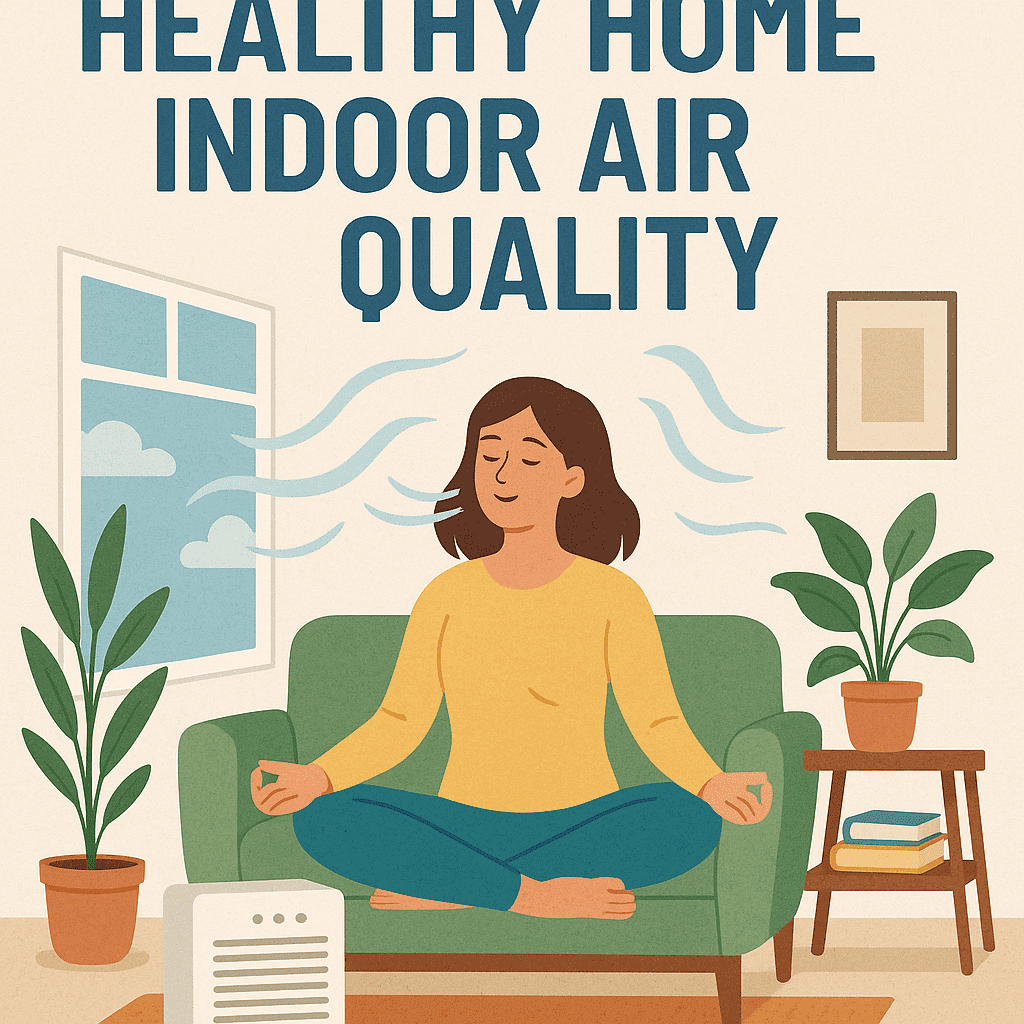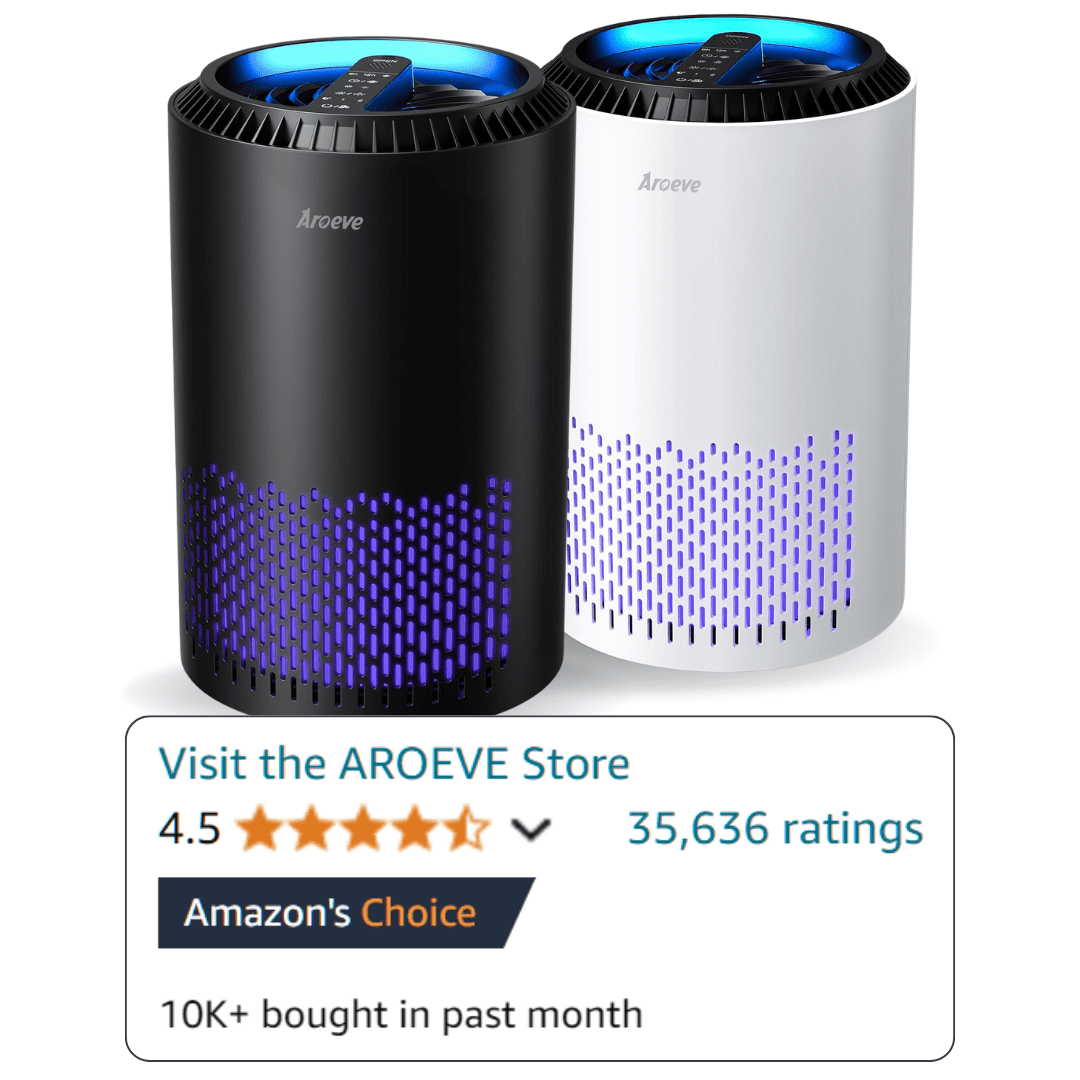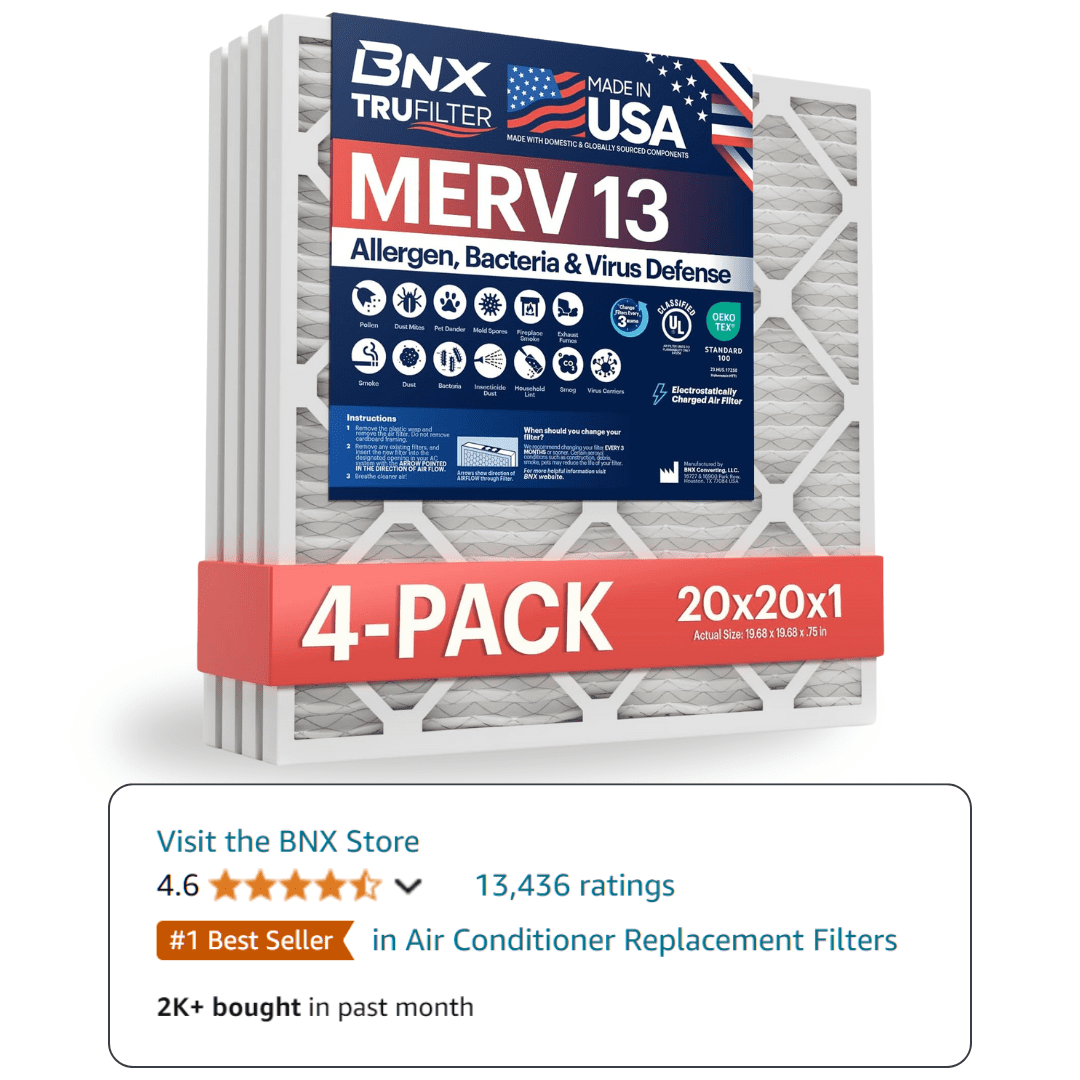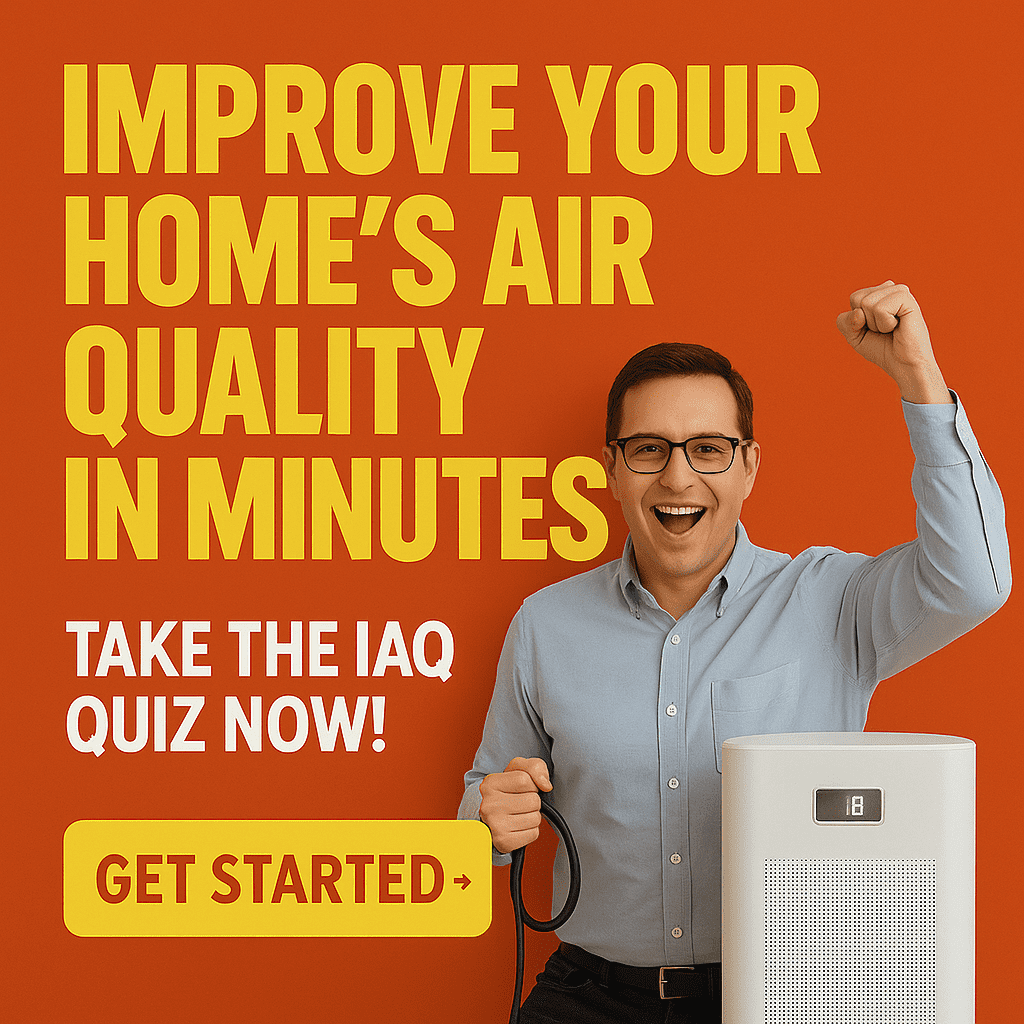Why Your Home’s Air Matters More Than You Think
Did you know the average person spends about 90% of their time indoors?
That’s a significant portion of your life spent breathing the air inside your home, office, or other enclosed spaces. Yet, while we often worry about outdoor pollution, the air quality inside our homes can be just as important, if not more so.
Indoor Air Quality (IAQ) refers to the condition of the air within and around buildings, particularly as it relates to the health and comfort of the occupants. Good IAQ is essential for maintaining a healthy living environment, as poor air quality can lead to a range of health issues, from minor irritations like headaches and fatigue to serious conditions such as respiratory diseases and heart problems.
Your home should be a sanctuary where you can relax, recharge, and feel safe.
But when the air inside is polluted, it can undermine your health, comfort, and even productivity. In this guide, we’ll explore the fundamentals of IAQ, uncover the hidden threats lurking in your home’s air, and provide practical, actionable steps to assess and improve indoor air quality.
Whether you’re a homeowner or a renter, this guide will empower you to take control of your living environment and breathe easier.
Common Indoor Air Pollutants
Indoor air pollutants are often invisible, but their effects can be very real. These contaminants come from a variety of sources, and understanding them is the first step toward improving your home’s air quality. Let’s break down the three main categories of indoor air pollutants: biological, chemical, and particulate matter.
Biological Pollutants
Biological pollutants are living organisms or come from living things. They include:
- Mold: Thrives in damp, humid areas like bathrooms, basements, and kitchens. Mold spores can trigger allergic reactions and asthma attacks.
- Dust Mites: Microscopic creatures that feed on dead skin cells and thrive in bedding, carpets, and upholstery. Their droppings can cause allergies and asthma.
- Pet Dander: Tiny flecks of skin shed by pets, which can trigger allergic reactions.
- Pollen: Enters from outside and can accumulate indoors, especially during allergy season.
- Bacteria and Viruses: Can spread through the air, especially in poorly ventilated spaces.
Health Effects: Exposure to biological pollutants can lead to sneezing, coughing, dizziness, and more severe respiratory issues. For those with asthma or allergies, these pollutants can exacerbate symptoms.
Chemical Pollutants
Chemical pollutants are gases or particles released from various household products and materials. Common examples include:
- Volatile Organic Compounds (VOCs): Emitted by paints, cleaning supplies, furniture, and building materials. Formaldehyde and benzene are particularly concerning VOCs.
- Radon: A naturally occurring radioactive gas that can seep into homes from the ground. Long-term exposure is a leading cause of lung cancer.
- Carbon Monoxide (CO): A colorless, odorless gas produced by incomplete combustion from sources like gas stoves, fireplaces, and car exhaust.
- Pesticides: Used to control pests but can linger in the air and on surfaces.
- Cleaning Supplies: Many contain harsh chemicals that release VOCs into the air.
Health Effects: Chemical pollutants can cause headaches, dizziness, nausea, and long-term exposure may lead to chronic respiratory issues, organ damage, or even cancer.
Particulate Matter (PM)
Particulate matter refers to tiny particles suspended in the air, often categorized by size:
- PM2.5: Fine particles smaller than 2.5 micrometers, which can penetrate deep into the lungs.
- PM10: Coarser particles between 2.5 and 10 micrometers, which can irritate the respiratory system.
Sources include dust, smoke, soot from cooking, smoking, and outdoor pollution (such as wildfires, a particular concern in California).
Health Effects: PM can cause eye, nose, and throat irritation, coughing, and shortness of breath. Long-term exposure is linked to respiratory diseases, heart problems, and reduced lung function.
Signs and Symptoms of Poor IAQ
Poor indoor air quality doesn’t always announce itself with a foul smell or visible haze. Often, the signs are subtle, but they can have a significant impact on your health and well-being. Here’s what to watch for:
Short-Term Health Effects
- Headaches and Fatigue: Frequent, unexplained headaches or a constant feeling of tiredness.
- Allergies and Irritation: Watery eyes, sneezing, coughing, or skin rashes.
- Dizziness and Nausea: Feeling lightheaded or sick to your stomach without a clear cause.
Long-Term Health Risks
- Respiratory Diseases: Chronic conditions like asthma, bronchitis, or other lung diseases.
- Cardiovascular Issues: Increased risk of heart disease or stroke.
- Cancer: Long-term exposure to certain pollutants like radon or formaldehyde can increase cancer risk.
Signs in Your Home
- Odors: Musty, chemical, or stale smells that don’t go away.
- Condensation: Excessive moisture on windows or walls, indicating high humidity.
- Visible Mold: Black, green, or white patches on walls, ceilings, or in corners.
- Excessive Dust: A constant layer of dust on surfaces, even after cleaning.
If you notice any of these signs or symptoms, it’s time to take a closer look at your home’s air quality. Read WHO guidelines from the NIH.
Assessing Your Home’s IAQ: Testing and Monitoring Options
Knowing whether your home’s air is healthy requires more than just guesswork. Fortunately, there are several ways to assess your IAQ, ranging from simple observations to professional testing.
Simple Observation & Sensory Checks
Start with your senses:
- Look for visible mold, water stains, or excessive dust.
- Smell for musty odors, chemical scents, or stale air.
- Listen for unusual sounds from your HVAC system, which could indicate airflow issues.
While these checks are a good starting point, they may not detect all pollutants, especially those that are odorless or invisible.
IAQ Monitors
IAQ monitors are devices that measure various air quality parameters:
- PM2.5 and PM10: Detect particulate matter from dust, smoke, or outdoor pollution.
- CO2: High levels can indicate poor ventilation.
- VOCs: Measure chemical pollutants from household products.
- Temperature and Humidity: Essential for preventing mold and dust mite growth.
Benefits: These monitors provide real-time data and can help you track changes over time. Limitations: They may not detect all pollutants, such as radon or carbon monoxide, and can be expensive.
Specific Pollutant Testing
For certain pollutants, specific tests are necessary:
- Carbon Monoxide Detectors: Essential for detecting this deadly gas. Place them near bedrooms and fuel-burning appliances.
- Radon Test Kits: Affordable and easy to use, these kits can detect radon levels in your home.
- DIY Mold Tests: These kits can help identify mold spores, but their accuracy is limited. For serious mold concerns, professional testing is recommended.
Professional IAQ Assessment
If you suspect a serious IAQ issue or have persistent symptoms, consider hiring a professional:
- What It Involves: A thorough home inspection, including air sampling, moisture readings, and HVAC evaluation.
- When It’s Needed: For unexplained health symptoms, after water damage, or when buying a new home.
Professional assessments provide the most accurate and comprehensive evaluation but can be costly.
The 3 Pillars of Improving Indoor Air Quality
Improving your home’s IAQ doesn’t have to be overwhelming. By focusing on three key strategies—source control, ventilation, and air cleaning—you can make significant strides toward healthier air.
Source Control: Eliminate or Reduce Pollutants at the Source
The most effective way to improve IAQ is to tackle pollutants where they originate:
- Use Low-VOC Products: Choose paints, furniture, and cleaning supplies labeled as low-VOC or VOC-free.
- Fix Leaks Promptly: Prevent mold growth by addressing water leaks and drying affected areas within 48 hours.
- Control Pests Naturally: Use traps or boric acid instead of chemical pesticides.
- Store Chemicals Properly: Keep paints, solvents, and cleaners in sealed containers in well-ventilated areas.
- Ban Indoor Smoking: Smoke is a major source of PM and VOCs.
Ventilation: Bring in Fresh Air, Remove Stale Air
Proper ventilation helps dilute indoor pollutants and bring in oxygen-rich outdoor air:
- Natural Ventilation: Open windows and doors when weather permits, especially after activities like cooking or painting.
- Mechanical Ventilation: Use exhaust fans in kitchens and bathrooms to remove moisture and odors. Ensure your HVAC system is properly maintained.
- Advanced Systems: Consider energy recovery ventilators (ERVs) or heat recovery ventilators (HRVs) for efficient air exchange, especially in newer, airtight homes. In California, Title 24 building codes require mechanical ventilation in new constructions to ensure adequate airflow.
Air Cleaning & Filtration: Remove Airborne Contaminants
While source control and ventilation are crucial, air cleaners can provide an extra layer of protection:
- HVAC Filters: Use filters with a high MERV rating (8-13) to capture smaller particles. Replace them every 3 months.
- Portable Air Purifiers: Effective for targeting specific rooms or areas. Look for models with HEPA filters for best results.
- Whole-House Systems: Integrated with your HVAC system, these can provide comprehensive air cleaning but are more expensive.
For more detailed information on air purifiers, check out our Air Purifier Guide.
Humidity Control and Regular Maintenance
Even with the three pillars, maintaining good IAQ requires attention to humidity and regular upkeep.
Humidity Control
- Ideal Levels: Keep indoor humidity between 40–60% to prevent mold and dust mite growth.
- Tools: Use dehumidifiers in damp areas like basements and humidifiers in dry climates or during winter.
Regular Maintenance
- Cleaning: Dust and vacuum regularly using a HEPA-filter vacuum to reduce allergens.
- HVAC Care: Change filters quarterly and schedule annual HVAC inspections. Consider duct cleaning if there’s visible mold or excessive dust.
- Monitor IAQ: Use IAQ monitors to track changes and identify issues early.
Your Home IAQ Health Checklist
Ready to take action? Use this checklist to start improving your home’s air quality today:
- [ ] Inspect for Mold and Moisture: Check bathrooms, basements, and under sinks for leaks or water damage.
- [ ] Use Low-VOC Products: Switch to eco-friendly paints, cleaners, and furnishings.
- [ ] Ventilate Regularly: Open windows daily, even for a few minutes, and use exhaust fans while cooking or showering.
- [ ] Change HVAC Filters: Replace every 3 months with MERV 8+ filters.
- [ ] Monitor Humidity: Aim for 40-60% humidity; use dehumidifiers or humidifiers as needed.
- [ ] Test for Radon: Use a radon test kit, especially if you live in a high-risk area.
- [ ] Install CO Detectors: Place near sleeping areas and check batteries regularly.
- [ ] Consider an Air Purifier: Use in bedrooms or high-traffic areas for added filtration.
- [ ] Schedule HVAC Maintenance: Have your system inspected annually.
Breathing Easier Starts Today
Improving your home’s indoor air quality is not a one-time task, it’s an ongoing commitment to your health and well-being.
You can create a safer, healthier living environment by understanding the common pollutants, recognizing the signs of poor IAQ, and implementing the three pillars of source control, ventilation, and air cleaning.
Remember, small changes can make a big difference.
Start with simple steps like opening windows, using low-VOC products, and maintaining your HVAC system.
Over time, these habits will help you breathe easier and live better.
Ready to Take the Next Step?
- Explore our in-depth guides on pollutants like Mold, VOCs, and Radon.
- Air Purifier Buyer’s GuideLearn more about choosing the right Air Purifier for your home.
- Browse our IAQ products selection to assess your air quality.
- For persistent issues, contact a highly rated, local IAQ professional.




